Empowerment of women is essential for the achievement of sustainable development. The full participation and partnership of both women and men is required in productive and reproductive life.
The 2008 NDHS explores women’s empowerment in terms of employment, type of earnings, control over cash and earnings and freedom of movement. The Women’s Questionnaire collected information on general background characteristics including age, education, and household wealth status, for women age 15-49. In addition, the 2008 NDHS collected information on other measures of women’s autonomy and status, particularly women’s roles in making household decisions. Information collected in the survey is used to estimate two indicators of women’s empowerment: women’s participation in household decisionmaking and women’s acceptance of wife beating. The extent to which women’s empowerment influences health outcomes (such as reproductive health care practices, contraceptive use, and unmet need) is also examined.
Employment and Form of Earnings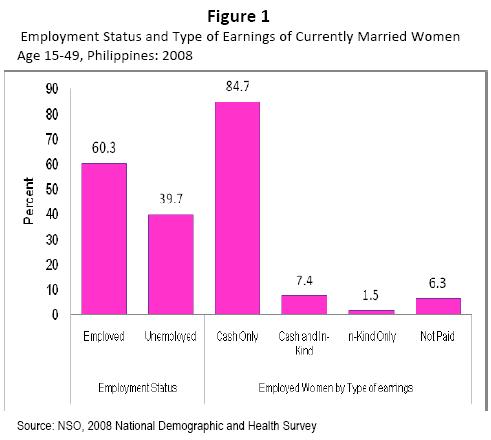
Three in every five of currently married women age 15-49 reported being employed in the 12 months before the survey (Figure 1).
Although employment is assumed to generate income, not all women receive earnings for the work they do. Furthermore, not all women who receive earnings are paid in cash. About 85 percent of currently married women who were employed in the past 12 months earn only cash, while 7 percent receive both cash and inkind payment, 2 percent receive in-kind payment only, and 6 percent do not receive any payment for their work.
Married Women’s Control Over Their Own Earnings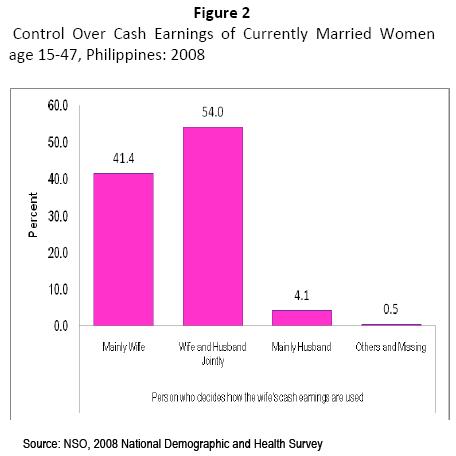
Besides having access to income, women need to have control over their earnings in order to be empowered. Two in five (41 percent) currently married women with cash earnings decide themselves how their earnings are used, while more than half (54 percent) say that they decide jointly with their husband (Figure 2). Only 4 percent of women said thattheir husband mainly decides how their earnings are used. The proportion of married women who say that they mainly decide themselves how their earnings are used has decreased from 60 percent in 2003 to the current level of 41 percent.
Figure 3 shows the findings on women’s cash earnings relative to those of their husband (more, less, or about the same). Overall, a majority (54 percent) say that they earn less than their husband while 22 percent say they earn more than their husband and 21 percent say they earn about the same.

Control Over Men’s Earnings
The extent of women’s participation in the family’s decisionmaking can also be measured by the amount of control they have over the use of their husband’s cash earnings. Figure 4 shows that for almost two-thirds (63 percent) of currently married women whose husbands receive cash earnings report that decisions about the use of the husband’s earnings are made jointly by the husband and wife. Surprisingly, 27 percent of women say that they themselves are the ones who mainly decide how their husband’s earnings are used.
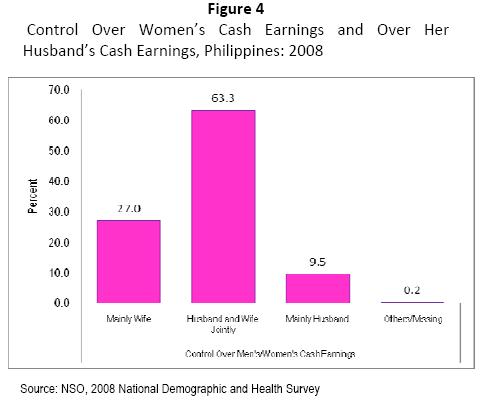 Women’s Participation in Decision-making
Women’s Participation in Decision-making
In the 2008 NDHS, currently married women were asked who usually makes decisions on four specific issues: decisions regarding her own health care; making major household purchases; making purchases for daily household needs; and making visits to her family or relatives. Figure 5 shows the percent distribution of currently married women age 15-49 by who usually makes these four decisions.
The results show that married Filipino women are usually involved in all four decisions, although the extent of their involvement depends on what is being decided. Almost six in ten women say they alone make decisions about purchases for daily household needs; however, decisions about visits to the woman’s family or relatives are most likely to be made jointly by the woman and her husband (70 percent). Decisions on making major household purchases are also likely to be made jointly (65 percent); however, 14 percent of women say their husband usually decides about major purchases. Half of married women say they make decisions themselves about their own health care, while 44 percent say they make such decisions jointly with their husband.
The higher the level of education, the more likely the woman is to participate in all four decisions (69 percent among women with no education, compared with 80 percent among women who attended college)
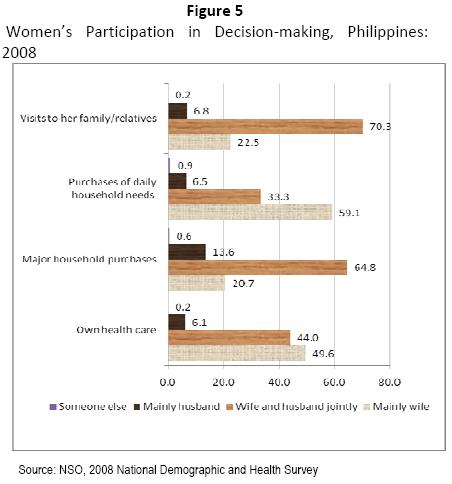
Indicators of Women’s Empowerment
To examine how selected demographic and health outcomes vary by indicators of women’s empowerment, information on women’s participation in decisionmaking and their attitudes towards wife beating are summarized into two indices. These indices are based only on women’s responses to the survey. The first index is the number of decisions in which women participate alone or jointly with their husbands. This index ranges in value 0 to 4 and is positively related to women’s empowerment. This index reflects the degree of control that women are able to exercise through making decisions in areas that affect their own lives and environments.
The second index, which ranges in value 0 to 5, is the number of reasons that a woman believes justifies a husband beating his wife. A lower score on this indicator is interpreted as reflecting a greater sense of entitlement, higher self-esteem, and a higher status of women. In general, it is expected that women who participate in making decisions are also more likely to disagree with all reasons for justifying wife beating. Note that the decisionmaking index is defined for currently married women, whereas the index on attitudes toward wife beating is defined for all women.
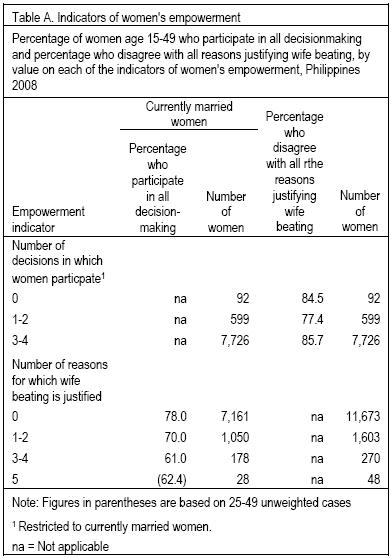 Table A provides a brief overview on how these two basic empowerment indicators – the number of decisions in which women participate and the number of reasons for which wife beating is justified – relate to one another. The relationship is not clear, partly because the vast majority of women fall in the higher group since they participate in making 3-4 decisions. Eighty-six percent of women who participate in three to four household decisions disagree with all reasons justifying wife beating. This percentage is higher than for women who participate in two or fewer decisions (77 percent).
Table A provides a brief overview on how these two basic empowerment indicators – the number of decisions in which women participate and the number of reasons for which wife beating is justified – relate to one another. The relationship is not clear, partly because the vast majority of women fall in the higher group since they participate in making 3-4 decisions. Eighty-six percent of women who participate in three to four household decisions disagree with all reasons justifying wife beating. This percentage is higher than for women who participate in two or fewer decisions (77 percent).
Attitudes Toward Wife Beating
The problems women face are many and diverse. One of the most serious is violence, particularly domestic violence. The 2008 NDHS obtained information on women’s attitudes towards wife beating. Women were asked whether a husband is justified in hitting or beating his wife under series of circumstances; it she burns the food, if she argues with him, if goes out without telling him, if she neglects the children, and if she refuses to have sexual intercourse with him. A woman’s attitude toward wife beating is considered to be a proxy for her perception of her status. A lower score on the “number of reasons wife beating is justified” indicates a woman’s greater sense of entitlement, self-esteem and status, and reflects positively on her sense of empowerment. In contrast, a woman who believes that a husband is justified in hitting or beating his wife for most or all of these reasons may consider herself to be low status, both absolutely and relative to men. Such a perception could act as a barrier to accessing health care for herself and her children, affect her attitude toward contraceptive use, and impact her general well-being.
Overall, 14 percent of women believe that a husband is justified in beating his wife for at least one of the reasons listed. The most widely accepted reasons for wife beating among women in the Philippines is neglecting the children (12 percent), followed by going out without telling her husband (5 percent). Three percent of women feel a husband is justified in beating his wife if she argues with him, while only 2 percent of women agree that a husband is justified in hitting or beating his wife if she burns the food or refuses to have sexual intercourse with him.
Approval of at least one reason for wife beating varies little with age. Women are less likely to accept wife beating for any reason if they live in an urban area, have attended college, or belong to the highest wealth quintile.
TECHNICAL NOTE
The 2008 National Demographic and Health Survey (NDHS) is ninth in a series of surveys conducted every five years since 1968 designed to assess the demographic and health situation in the country. The 2008 NDHS provides basic indicators on fertility, childhood mortality, contraceptive knowledge and use, maternal and child health, nutritional status of mothers and children, and knowledge, attitude and behavior regarding HIV/AIDS and tuberculosis. For the first time, data on violence against women were collected in this round of NDHS. Fieldwork for the 2008 NDHS was carried out from August 7 to September 27, 2008 covering a national sample of approximately 13,000 households and 14,000 women aged 15-49 years.
The 2008 NDHS Final Report is available at the Demographic and Social Statistics Division (DSSD) of the Household Statistics Department, NSO, Solicarel Building 1, Ramon Magsaysay Boulevard, Sta. Mesa, Manila (Telephone: (632) 713-7245; Fax (632) 716-1612), or by writing to e-mail address: info@census.gov.ph
